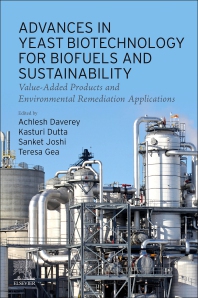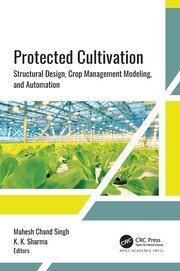
Book
Advances in Yeast Biotechnology for Biofuels and Sustainability : Value-Added Products and Environmental Remediation Applications
ISBN : 9780323954495
Author : Achlesh Daverey
Publisher : Elsevier
Year : 2023
Language : English
Type : Book
Description : Table of contents Cover image Title page Table of Contents Copyright Dedication List of contributors Preface Section One. Yeast biotechnology for the sustainable production of biofuels 1. Past, present and future of yeast engineering 1. Introduction 2. History of yeast 3. Biotechnology and yeast as model organism 4. Genetic engineering of yeast 5. Conclusion 2. Engineered yeasts for the production of biofuel and platform chemicals 1. Introduction 2. Biofuel and chemicals production by conventional yeast 3. Need for engineered yeast for biofuel and chemicals production 4. Available tools for genetic manipulation of yeasts 5. Engineered yeast for biofuel production 6. Engineered yeast for bio-based platform chemical production 7. Conclusion and future prospective 3. Engineered yeasts for lignocellulosic bioethanol production 1. Introduction 2. Properties of lignocellulose 3. Conventional methods of lignocellulose biomass processing for fermentation 4. Yeasts in bioethanol production 5. Types of bioethanol fermentation 6. Genetic engineering of yeasts for bioethanol production from lignocellulosic biomass 7. Metabolic engineering of yeasts for the production of bioethanol from lignocellulose 8. Consolidated bioprocessing of yeasts for improved ethanol fermentation 9. Concluding remark 4. Metabolic engineering of yeast for advanced biofuel production 1. Introduction 2. Synthetic biology tools in engineering yeast for advanced fuels 3. Advanced fuels produced from engineered yeasts 4. Scale-up and its challenges in yeast-derived biofuel production 5. Future prospects and conclusion 5. Engineering of nonconventional yeasts for valuable products including bioethanol 1. Introduction 2. Ethanol 3. Production of polyols from yeasts 4. Production of carotenoids from yeasts 5. Conclusion 6. Oleaginous yeasts: phylogenetic diversity and strain selection for biodiesel production 1. Introduction 2. History of oleaginous yeast research 3. Phylogenetic diversity of oleaginous yeasts 4. Discovery of oleaginous yeasts for biodiesel production 5. Factors affecting species selection 6. Conclusions 7. Waste valorization for biofuel production by oleaginous yeast 1. Introduction 2. Waste from different sources and their characteristics 3. Biofuel production from different wastes using oleaginous yeasts 4. Conclusion 8. Engineered yeast for the hydrolysis of algae—a potential alternative feedstock for biofuel production 1. Introduction 2. Enzymatic disruption of algal cells 3. Simultaneous saccharification and fermentation of algal biomass 4. Conclusions and future prospects Section Two. Wild and engineered yeasts for value-added products, environmental sustainability, and sustainable agriculture 9. Applications of yeast for environmental clean-up and sustainable agriculture 1. Yeast bioprospecting and metagenomics: from classical to modern applications for agriculture and environment 2. Systems biology in yeast: genomic-based strain selection and improvement for biotechnological applications (white, green, and gray biotechnology) 3. From biotechnology to nanotechnology of yeast: new products/devices, biomaterials, nanofertilizers, nanopesticides, nanobioremediation, and others 4. Concluding remarks 5. Future trends 10. Cleaner production of biosurfactants from yeasts 1. Introduction 2. Biosurfactant as a clean alternative: definition, current market, and potential applications 3. Microbial biosurfactant 4. Sustainable production of biosurfactants 5. Conclusion 11. Fungal enzymes and biotechnological approaches to enhance their production in yeasts 1. Yeasts heterologous protein expression systems 2. What are fungal enzymes and their types? 3. Industrial applications of fungal enzymes 4. Recent approaches to enhance the fungal enzyme production in yeasts 5. Conclusion 12. Engineered yeast for the production of bioplastics 1. Introduction 2. Bioplastic 3. Bioplastics microbial production 4. Yeast as a microbial cell factory 5. PHB biosynthetic pathways in yeast 6. Bioplastic production using recombinant yeast 7. Why are scientists interested in eukaryotic rather than prokaryotic systems for bioplastic production? 8. Recommendations and future perspectives 9. Conclusions 13. Yeasts as a source of pigments of biotechnological interest 1. Introduction: synthetic chemical compounds and natural pigment 2. Pigment-producing yeasts 3. Optimization of pigment production by yeasts 4. Yeast pigments: extraction, purification, and characterization strategies 5. Main applications of pigments produced by yeasts 6. Perspectives for the world pigment market 7. Conclusion 14. Engineered yeasts for high-value carotenoid production 1. Introduction 2. Engineered red yeasts for the production of high-value carotenoids 3. Engineered Rhodotorula and Sporobolomyces species 4. Engineered Phaffia rhodozyma 5. Engineered non-carotenogenic yeasts for the production of high-value carotenoids 6. Engineered Saccharomyces cerevisiae 7. Engineered Yarrowia lipolytica 8. Alternative feedstocks for microbial carotenoid production 9. Conclusion 10. Future perspectives 15. The utilization of yeast for industrial wastewater treatment 1. Introduction 2. Yeast opportunities for secondary and tertiary wastewater treatment 3. Wastewater treatment by yeast 4. Simultaneous wastewater treatment and lipid production by yeast for biodiesel production 5. Conclusion and perspectives 16. Biodegradation of azo dyes by yeasts 1. Introduction 2. Azo dye characterization and classification 3. Environmental effects of azo dye effluents 4. Biodegradation of azo dye 5. Azo dye degrading yeasts 6. Effect of different factors of biodegradation efficiency 7. Integrated techniques for azo dye degradation 8. Future perspectives 9. Conclusion 17. Bioremediation of oil-contaminated soil by yeast bioaugmentation 1. Introduction 2. Oil contamination of soil 3. Oil degradation in yeast cells 4. Yeast bioaugmentation: an ecological alternative for oil-contaminated soil bioremediation 5. Bioaugmentation—present limitations and future perspectives 6. Conclusions 18. Engineered yeasts as biocatalysts for pesticide degradation 1. Introduction 2. Molecular tools for pesticide bioremediation 3. Recombinant yeast: a plausible system for bioremediation 4. Recent advances in yeast engineering 5. Challenges and future prospects 19. Bioremediation of heavy metals using yeast 1. Introduction 2. Bioremediation 3. Role of yeast in bioremediation 4. Factors influencing heavy metal removal by yeast 5. Mechanisms of yeast bioremediation 6. Bioremediation process by yeast cells 7. Advantages of yeast bioremediation 8. Industrial applications 9. Concluding remarks 20. Engineered yeast as a hyperaccumulator for heavy metal removal and recycling from waste streams 1. Introduction 2. Heavy metal pollution 3. Different techniques for heavy metals removal 4. Genetically engineered yeast for heavy metal removal 5. Conclusion and future perspectives 21. Extremophilic yeasts and their potential in bioremediation of polluted environments 1. Introduction 2. Main molecular mechanisms of extremophilic and extremotolerant yeasts 3. Extremophilic yeast fermentation and its potential applications in bioremediation 4. Technological innovation in extremophilic yeasts 5. The drawbacks and future challenges of bioremediation using extremophilic yeasts 22. Yeast–plant interactions for phytoremediation of contaminated soils 1. Introduction 2. Phytoremediation fundamentals 3. Plant–yeast interaction in phytoremediation 4. Recent approach of remediation of pollutants with yeast–plants 5. Economic aspects of yeast in phytoremediation 6. Conclusion and future perspectives on yeast–plant phytoremediation 23. Role of genetically engineered yeast in plastic degradation 1. Introduction 2. Impact of plastic waste on ecosystem 3. The need for biodegradable plastics 4. Microorganisms involved in plastic degradation 5. Yeast as an organism in bioremediation and the role of its enzymes in biodegradation 6. Genetically engineered yeast and synergistic activity of chimeric enzymes in plastic degradation 7. Obstacles faced and prospects of plastic degradation by yeast 8. Conclusion Index








